
Why take home a taxi-load of anonymous self-assembly flat-pack furniture, when for much the same price you can fill your apartment with elegant traditional Chinese pieces?

(This article is for information purposes only. Imperial Tours is not in involved in any capacity with the antique or reproduction furniture business. Our links page introduces various Chinese and western furniture websites. We have no business relationship with these websites, and our links are not to be interpreted as recommendations. We advise caution when contacting these companies.)
 Opening the door to your astronomically-priced expat housing, you are appalled by the gaudiness of the furniture inside. It's so out of date that even your grandmother would smile in embarrassment. Tensions rise to the surface when visitors drop by – friends, colleagues…your boss. Is there any way of silencing their grating offers of sympathy, or of replacing their latent discomfort with open admiration?
Opening the door to your astronomically-priced expat housing, you are appalled by the gaudiness of the furniture inside. It's so out of date that even your grandmother would smile in embarrassment. Tensions rise to the surface when visitors drop by – friends, colleagues…your boss. Is there any way of silencing their grating offers of sympathy, or of replacing their latent discomfort with open admiration?
Fortunately, there is.
Beijing is replete with sophisticated furniture sellers and skilled craftsmen, whose ready services can be employed to restore your interiors to elegant grace. But before you rush to a furniture maker, equipped with your sketch of a swimming-pool-sized daybed, or to Guang Han Tang Antiques, credit card in hand, you should prime yourself with some background information. This will mark you out as a knowledgeable rather than a naive customer.
Categories of furniture
To tilt the shopkeeper's opinion in your favor, you should start by identifying furniture pieces by their proper names. Chinese furniture began to take its present form during the Northern Song Dynasty. Since then the following terminology has been used, as shown in the table below:
| Chinese homophone | English | Special characteristics | Image |
| Stools | |||
| Dengzi | Stool, bench | Square, rectangular or round |
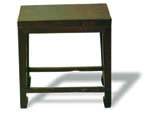 |
| Zuodun | Stool | Barrel-shaped stool |
 |
| Jiaoyi | Folding chair | Seats made of rattan |
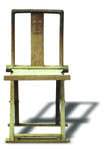 |
| Chinese homophone | English | Special characteristics | Image |
| Chairs | |||
| Fushouyi | Armchair |
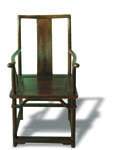 |
|
| Kaobeiyi | Yolk-back chair | Without armrests |
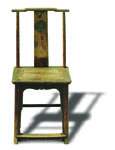 |
| Guanmaoyi | Official's hat chair | Top of backrest has wings like an official's hat |
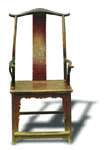 |
| Quanyi | Horse-shoe chair | Back is horse-shoe shaped |
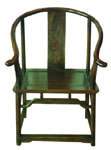 |
| Chinese homophone | English | Special characteristics | Image |
| Tables | |||
| Tiao'an | Entrance table | Long and narrow |
 |
| Hua'an Shuan | Writing table | Wider than entrance table |
 |
| Kangzhuo | Bed table | Small in size & low |
 |
| Fangzhuo | Square table |
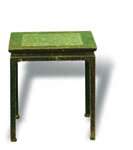 |
|
| Huaji Xiangji | Plant stand, incense stand | Long and high legs |
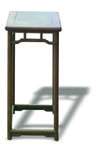 |
| Chinese homophone | English | Special characteristics | Image |
| Shelves | |||
| Jiage | Storage shelf |
 |
|
| Chinese homophone | English | Special characteristics | Image |
| Cabinets | |||
| Yuanjiaogui | Round-sided cabinet |
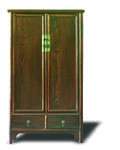 |
|
| Fangjiaogui | Square-sided cabinet |
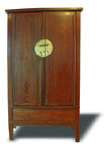 |
|
| Chinese homophone | English | Special characteristics | Image |
| Beds | |||
| Ta | Daybed | No sides |
 |
| Luohanchuang | Opium Bed | Has three sides; resembles a couch |
 |
| Jiazi chuang | Canopy Bed | Wooden canopy encloses bed |
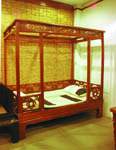 |
In ensuing discussions, you may also find the following vocabulary helpful:
Useful words and phrases
| Chinese Homophone | English | Chinese Homophone | English |
| Chang | long | Changdu | length |
| Kuan | wide | Kuandu | width |
| Gao | high | Gaodu | height |
| Hou | thick | Houdu | thickness |
| Shen | dark | Shendu | darkness |
| Qian | light |
Not all woods are made equally
Crucial to the price and quality of your furniture is the wood used for it.
Recently, we had the pleasure of walking through a Hebei forest with Laurent Colson, a Parisian antique dealer. Indicating the various trees around us, he explained which wood was esteemed during each dynastic period to manufacture the various categories of furniture. Only if, like him, you trade at esoteric levels of the antique market do you need such encyclopedic knowledge. For most of us, it is enough to know which woods are the traditional signifiers of high quality furniture.
The table below presents the characteristics of the most commonly used woods. Grades 1-4 (grade 1 is the best) designate the hardwoods while grades 5-7 designate the lesser quality and more commonly available softwoods.
| Chinese homophone | English | Colour | Characteristics | Grade |
| Zitan | Red Sandalwood | Reddish-brown to golden-yellow | Shimmering surface with abstract patterns | 1 |
| Huanghuali | Yellow Rosewood | Blackish-purple to blackish-red | Fine, lustrous surface | 2 |
| Jichimu | Chicken-wing Wood | Deep brown | Brown, gray patterns resembling feathers | 3 |
| Tieli | Iron Wood | Grayish black | Coarse texture | 4 |
| Hongmu | Chinese Mahogany | Reddish-brown to blackish-red | Used only after the 18th century | 5 |
| Nanmu | Evergreen Laurel | Olive-brown to reddish-brown | Shimmering surface, smooth texture | 5 |
| Hetao | Walnut | Golden-brown to reddish-brown | Open-grained texture; fragrant | 6 |
| Jumu | Southern Elm | Yellowish-brown to coffee-brown | Medullary rays; feathery patterns | 6 |
| Zuomu | Oak | Grayish-yellow to grayish-brown | Medullary rays; lustrous flakes | 6 |
| Yumu | Northern Elm | Yellowish-brown to chestnut-brown | Layered, feather-like patterns | 7 |
| Zhangmu | Camphor | Reddish-brown | Light/dark striped pattern; strong fragrance | 7 |
Hardwoods
Zitan (red sandalwood) and Huanghauli (yellow rosewood), the premier hardwoods, were traditionally sourced from Hainan Island, but now are also available from other tropical parts of Southeast Asia. Jichimu (chicken-wing wood) and Tieli (iron wood) come from Fujian and Guangdong provinces.
Hardwood furniture, however, was not necessarily manufactured near its source. Just as important as the woods' geographic distribution, was the availability of craftsman skilled enough to work them. For instance, the best Huanghuali furniture was known to hail from Jiangsu province, because specialist craftsmen during the Ming and Qing dynasties (mid-15th to early-20th centuries) assembled there to work with it.
Softwoods
Typically these are woods easily sourced by local craftsmen. Since they are readily available, they are used for more common pieces of furniture. They comprise the bulk of furniture in today's market, ranging from Yumu (northern elm) and Huaimu (locust)-in the northern provinces of Hebei and Shanxi-to Jumu (southern elm)-in Jiangsu province-and Xiangzhang (camphor)-in the south.
Let the shopping begin!
Notwithstanding that a little knowledge-especially when backed with good credit-is a dangerous thing, let's go shopping. You have three purchasing routes open to you. Firstly, to buy genuine antiques, secondly to purchase reproductions, and lastly to organize the design and purchase of your own made-to-order furniture. The price comparisons below give only a general indication of the prices of comparable objects. Prices listed are not exact and, of course, do not include the discounts able negotiators may be able to obtain.
| Furniture category | Antique | Reproduction | Made to order |
| Opium Bed |
US$1,800+ |
US$1,200 (Northern Elm) |
US$360 (Northern Elm) |
| Horse-shoe chair |
US$850+ (Northern Elm) |
US$600 (Northern Elm) |
US$100 (Northern Elm) |
| Dining table & chairs (8) |
US$2,500+ (Northern Elm) |
US$1,800 (Northern Elm) |
US$1,800 (Northern Elm) |
| Armoire |
US$1,200+ (Southern Elm) |
US$400 (Northern Elm) |
US$360 (Northern Elm) |
Tips for buyers
Antiques
If you are interested in the top end of this market, the first thing to note is that Beijing does not necessarily offer the most reasonable prices. At this level, prices are set internationally. You should compare prices at Guang Han Tang and Hua Yi with dealers located in Hong Kong, New York, Paris and London.
Otherwise, there are two laws well worth knowing. Firstly, if a Chinese dealer misrepresents an antique, i.e. sells you a fake instead of the real thing, under article 49 of the PRC's Consumers' Rights Law, you are entitled to a penalty of at least double the value of the sale. Secondly, when it comes to leaving the country-you are legally obliged to have your purchased antiques valued by the Customs Office (something which most international moving companies will arrange for you). Chinese law stipulates that antiques which are older than 300 years are not allowed to be exported out of the country. This law, however, does not apply to all woods, but to the more valuable zitan, huanghuali and jichimu woods. As laws do change, it is advisable that you confer with the store to make sure that you will be allowed to take your purchases home.
Although most antique stores will guarantee the quality of their goods, the value of such warranties is negligible once you have left the country.
Reproduction
The main thing to watch out for when in the market for reproduction furniture is to verify that the piece has been made using aged wood ("lao mu" in Mandarin Chinese). If the wood is more than eighty years old, it will have dried properly. Consequently, during winter when all woods contract, the resulting separation will be kept to a minimum. Should your furniture crack down the middle of a panel, this is a clear sign that new wood was used.
If, however, a certain degree of separation occurs at the junction of two or more panels, do not worry. This is to be expected.
Made to order
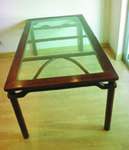 If you aren't a trained designer, the easiest way of going about this process is to first purchase a design or photographic book of Chinese furniture. While there are numerous coffee table books, one of the most useful is Illustrated Chinese Furniture Through the Ages by Ruan Chanjiang (ISBN 7-5344-0233-6/J234). This book contains line drawings of many of the pieces, featuring not only the various categories of furniture but also numerous stylistic variations for each particular category. Another good reference book is Illustrated Chinese Furniture of the Ming Dynasty by Jing Ronghua and Shuai Ciping (ISBN 7-5038-2393-3/TB0318) which has photographs of some of the more popular pieces of Ming dynasty furniture. Both books can be found in Liulichang.
If you aren't a trained designer, the easiest way of going about this process is to first purchase a design or photographic book of Chinese furniture. While there are numerous coffee table books, one of the most useful is Illustrated Chinese Furniture Through the Ages by Ruan Chanjiang (ISBN 7-5344-0233-6/J234). This book contains line drawings of many of the pieces, featuring not only the various categories of furniture but also numerous stylistic variations for each particular category. Another good reference book is Illustrated Chinese Furniture of the Ming Dynasty by Jing Ronghua and Shuai Ciping (ISBN 7-5038-2393-3/TB0318) which has photographs of some of the more popular pieces of Ming dynasty furniture. Both books can be found in Liulichang.
One advantage to buying made-to-order furniture is that you can adapt pieces according to your particular needs. For instance, traditional Chinese dining sets are often enormous in size, suitable for the spacious courtyards homes of the Ming and Qing elite, but perhaps not as suitable for the tiny New York apartment which may one day house them. In addition to such practical changes as customizing the dimensions, you may want to alter pieces according to your aesthetic preferences. For instance, a traditional dining table may be adapted by using a glass table top rather than a wooden one (see left), or the design of a mirror made to mimic the decorative motif of the more traditional entrance table(see right).

One word of caution-Beijing furniture makers, for obvious reasons, are better at making traditional Chinese styles. Taking a copy of Architectural Digest or Elle Decor and expecting them to copy the Western or modern designs is not recommended. Also beware that ordering your own furniture typically involves a great deal of supervision. Mr. Hou Xiaodong, for instance, will always let you inspect the structure of the piece before varnishing it. Once you've approved the structure, he will ask you to specify the color of the varnish. (This usually involves looking around his storage room for one that you like.) And before delivering the final product, he will invite you to inspect the piece a last time to approve the varnish. Though this process may sound tedious, it is advisable to invest as much care and interest in inspecting your furniture as you would expect him to do in manufacturing it.
Lastly, to care for your furniture, do not clean it with a spray-on furniture polish or with a wet cloth. Wipe it regularly with a dry cloth, and every 3 months apply a high-quality furniture wax such as Manson Wax.
By so doing, you will not only assure your own continuing satisfaction, but that of your friends, colleagues, and perhaps even your boss. Happy shopping.
Guy Rubin and Nancy Kim are the founders of Imperial Tours. They can be contacted via web_inquiry@imperialtours.net. Laurent Colson runs his antique furniture business from Galerie Luohan, 21 quai Malaquais, 75006 Paris.
July 20-August , 2000 CITY WEEKEND
(All photographs © City Weekend)